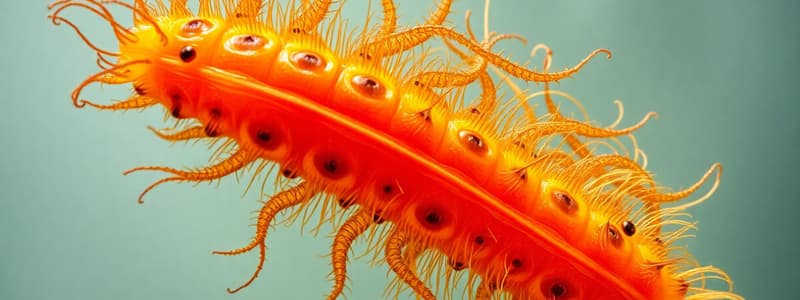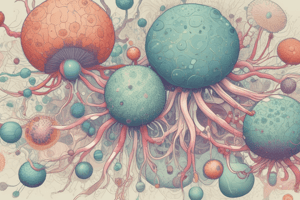Podcast
Questions and Answers
Kingdom Plantae contains both unicellular and multicellular organisms.
Kingdom Plantae contains both unicellular and multicellular organisms.
False (B)
All multicellular organisms are part of the domain Eukarya.
All multicellular organisms are part of the domain Eukarya.
True (A)
Kingdom Animalia organisms are non-motile and have cell walls.
Kingdom Animalia organisms are non-motile and have cell walls.
False (B)
Kingdom Protista contains both autotrophs and heterotrophs.
Kingdom Protista contains both autotrophs and heterotrophs.
Gamma diversity measures the variation in species between two ecosystems.
Gamma diversity measures the variation in species between two ecosystems.
Stable ecosystems typically have high diversity and many species to fill ecological roles.
Stable ecosystems typically have high diversity and many species to fill ecological roles.
Kingdom Fungi includes only multicellular organisms.
Kingdom Fungi includes only multicellular organisms.
Species biodiversity is concerned with the variation of genetic material within an ecosystem.
Species biodiversity is concerned with the variation of genetic material within an ecosystem.
Domains are classified into kingdoms based on evolutionary evidence.
Domains are classified into kingdoms based on evolutionary evidence.
Genetic biodiversity often involves the study of genomes.
Genetic biodiversity often involves the study of genomes.
Abiotic factors in ecosystems include living organisms like bacteria and fungi.
Abiotic factors in ecosystems include living organisms like bacteria and fungi.
Stable ecosystems with high diversity typically recover faster from environmental disturbances.
Stable ecosystems with high diversity typically recover faster from environmental disturbances.
Symbiotic relationships always benefit the organisms involved.
Symbiotic relationships always benefit the organisms involved.
Competition between species limits reproductive potential by competing for the same resources.
Competition between species limits reproductive potential by competing for the same resources.
Endosymbiosis is when an organism lives on the surface of another organism.
Endosymbiosis is when an organism lives on the surface of another organism.
Herbivory is a type of predation involving plants as prey.
Herbivory is a type of predation involving plants as prey.
Camouflage is a strategy used exclusively by predators to catch prey.
Camouflage is a strategy used exclusively by predators to catch prey.
Commensalism is a symbiotic relationship where one organism benefits, and the other is unaffected.
Commensalism is a symbiotic relationship where one organism benefits, and the other is unaffected.
Mimicry involving harmful and non-harmful species is known as Mullerian mimicry.
Mimicry involving harmful and non-harmful species is known as Mullerian mimicry.
Parasitic relationships typically benefit the host organism.
Parasitic relationships typically benefit the host organism.
Flashcards
Multicellular organisms
Multicellular organisms
Organisms composed of multiple cells, belonging to the domain Eukarya and possessing eukaryotic cells.
Biodiversity
Biodiversity
The study of the variety of life on Earth, encompassing species, genetic, and ecological diversity.
Alpha diversity
Alpha diversity
Measures the number of different species within a particular ecosystem.
Beta diversity
Beta diversity
Signup and view all the flashcards
Gamma diversity
Gamma diversity
Signup and view all the flashcards
Genetic diversity
Genetic diversity
Signup and view all the flashcards
Ecological diversity
Ecological diversity
Signup and view all the flashcards
Niche
Niche
Signup and view all the flashcards
Autotrophs
Autotrophs
Signup and view all the flashcards
Heterotrophs
Heterotrophs
Signup and view all the flashcards
Ecosystem Resilience
Ecosystem Resilience
Signup and view all the flashcards
Abiotic Factors
Abiotic Factors
Signup and view all the flashcards
Ecosystem
Ecosystem
Signup and view all the flashcards
Biotic Factors
Biotic Factors
Signup and view all the flashcards
Limiting Factors
Limiting Factors
Signup and view all the flashcards
Symbiotic Relationship
Symbiotic Relationship
Signup and view all the flashcards
Obligate Symbiosis
Obligate Symbiosis
Signup and view all the flashcards
Facultative Symbiosis
Facultative Symbiosis
Signup and view all the flashcards
Predator
Predator
Signup and view all the flashcards
Prey
Prey
Signup and view all the flashcards
Study Notes
Multicellular Organisms
- Multicellular organisms are composed of multiple cells
- All belong to the domain Eukarya and are made of eukaryotic cells
- Domains are grouped based on evolutionary traits (gene sequences, rRNA)
- Further classified into kingdoms
- Four main kingdoms with multicellular organisms: Plantae, Protista, Fungi, Animalia
- Plantae and Protista contain multicellular autotrophs (produce their own food)
- Plant cells are specialized with chloroplasts
- Animalia contains multicellular heterotrophs (obtain energy from consumption)
- Motile (able to move) and lack cell walls
- Protista, Plantae, and Fungi may have both unicellular and multicellular members
- Fungi and protists possess cell walls
Biodiversity
- Biodiversity measures variation within living systems
- Divided into three categories: species, genetic, and ecological
- Species biodiversity:
- Alpha diversity: species count in one ecosystem
- Beta diversity: species variation between ecosystems
- Gamma diversity: total species across all ecosystems
- Genetic biodiversity: variation in genetic material within a population
- Focuses on the genome (organism's complete DNA)
- Ecological biodiversity: number of ecosystems within a region
- Microclimates (variations in climate over small areas)
- Biodiversity is measured at various scales and levels
Abiotic Factors in Ecosystems
- Abiotic factors are non-living components of an ecosystem (physical and chemical parts of the environment)
- Ecosystems are the spaces where living and non-living things interact
- Ecosystems include populations interacting through trophic relationships and using available space
- Also include biotic factors (living things - viruses, bacteria, fungi, plants, animals)
- Limiting factors: abiotic factors that have minimum survival requirements for species (water, temp., O2, sunlight)
- Examples of other abiotic factors: wind, hurricanes, soil chemistry, cloud cover, earthquakes, human contamination
Symbiosis
- Symbiosis: long-term interaction between species
- May benefit both, one, or neither
- Obligate vs. facultative (essential vs. optional)
- Diverse impacts (negative, neutral, positive)
- Includes microorganisms, plants, fungi, and animals
- Types of symbiotic relationships:
- Mutualism: both benefit
- Commensalism: one benefits, other is unaffected
- Amensalism: one harmed, other unaffected
- Parasitism: one benefits (parasite), other harmed (host)
- Competition: both harmed (for resources)
- Mimicry: one species resembles another
- Co-evolution: species evolve in response to each other's changes
Predation & Coevolution
- Predation: one organism hunts and eats another
- Prey: organism being eaten (plants or animals)
- Herbivory: prey is a plant
- Predation is a strong selective force for prey
- Coevolution: species evolve in response to each other's evolution
- Adaptations for predators and prey:
- Camouflage (blending)
- Chemical defenses (toxins)
- Mimicry (resembling dangerous species)
- Batesian mimicry: harmless resembles harmful
- Müllerian mimicry: multiple harmful species share warning signals
Studying That Suits You
Use AI to generate personalized quizzes and flashcards to suit your learning preferences.




